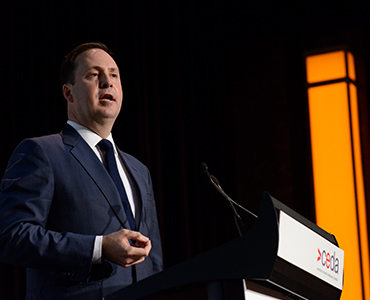Service exports represent a tremendous opportunity for Australia, Federal Minister for Trade, Tourism and Investment, the Hon. Steven Ciobo has told a CEDA audience in Melbourne.
 “We’ve seen over the past three to five years, roughly a third of Australia’s economic growth has been driven by trade growth. Yet, service exports only account for roughly 23 per cent of our exports,” he said.
“We’ve seen over the past three to five years, roughly a third of Australia’s economic growth has been driven by trade growth. Yet, service exports only account for roughly 23 per cent of our exports,” he said.
“Four in five jobs in our economy is services based.
“We’ve made services trade a key driver of our negotiations with other countries as we’ve sought to engage them either bilaterally or regionally.
“On the services side we can see the success of a number of businesses.
“If you look up for example Ramsay Health, or GroupGSA Architects, these are businesses that are leading the charge for our nation in relation to South East Asia.
“Big employers (with) high value add (and) shipping and exporting Australia’s model…to parts of the world which have different models to us or approaches that historically (have) been less efficient or perhaps less sensitive to market needs.
“As we see an ageing population in Japan, China, we see opportunities in relation to, for example aged care in new markets.
“Australia should be at the forefront of providing opportunity for Australian businesses to expand into those markets and sell our intellectual property.”
Mr Ciobo said one of the strongest countries with opportunities is India.
“From my perspective coming into this role…looking over the years of negotiations beforehand…it became apparent that it was going to be quite difficult for us to conclude a high quality comprehensive FTA with India,” he said.
“That is part of the reason why the Prime Minister and I were focused on what is a new pathway forward?
“And that is what lay at the core of the work that Peter Varghese, the former DFAT Secretary undertook in relation to the India Economic Strategy.
“For both government and business, the Strategy…offers a rich resource that will continue to be useful for many years to come.
“On any measure our economic relationship with India is underdone.
“It is very much in Australia’s interest to be able to fix this.
“By 2025, one-fifth of the world’s working age population will be Indian. By 2030, it is forecast there will be over 850 million internet users in India.
“India’s tertiary-age population, aged 18 to 22, is already the largest in the world and is projected to peak at 126 million in 2026 before stabilising at around 118 million by 2035.
“By 2030, India aims to lift its university enrolment rate to 50 per cent, which would mean that one in four graduates in the world would be a product of the Indian higher education system.
“Peter Varghese and the economic strategy outlines the opportunities he sees.”
Mr Ciobo said it is unsurprising that education is the top opportunity.
“The Strategy also identifies 10 Indian states that should, sooner rather than later, become household names as a focus for Australia’s engagement with India,” he said.
Mr Ciobo said this included Maharashtra, the country’s most economically advanced state; Mumbai, which serves as both India’s financial and film centre; and Bengaluru, which he described as “India’s Silicon Valley.”
“The India Economic Strategy details the opportunities that exist for Australian business in these states and the others that hold the greatest promise now and into the future,” he said.
“We as two nations have so much to gain from being able to engage in a constructive way.
“The targets that are outlined in this report…if achieved, could see goods exports grow from $120 million today, to $45 billion in today’s dollars by 2035. This is an exciting prospect for Australian producers.”
Mr Ciobo also discussed the status of global trade negotiations and attitudes towards trade.
“What we increasingly see, where what has essentially been policy orthodoxy for a long time…liberalised trade and liberalised investment, coming under significant pressure,” he said.
“Part of that pressure without any shadow of a doubt is coming from much of the rhetoric and less of the action – although some of the action – from of course our good friend, the United States.
“We also see in response to some of the tariffs that have been put in place…retaliatory tariffs have been put in place by, among others, Canada, Mexico, the European Union, (and) China.
“There can be a lot of speculation as to why is that happening. Is President Trump able to say, well trade isn’t working for people?
“Is there a broader popular sentiment out there that we see in parts of Europe and parts of Australia where we see the likes of Pauline Hanson and Nick Xenophon tap into, which says that trade isn’t working for Australians?
“Part of my challenge as Australia’s Trade, Tourism and Investment Minister is to address that and to address that in a headfirst way, to make sure that we…speak to the myriad of benefits that flow from liberalised trade.
“How do we ensure that people have faith and confidence in knowing there is a net positive that flows from trade but as Government, make sure we have the policy levers available to us to ensure we address some of the downsides – whether they are actual or not the fact is they’re perceived – that flow from trade.”
Also speaking at the event was Asialink Group Chief Executive Officer, Penny Burtt.